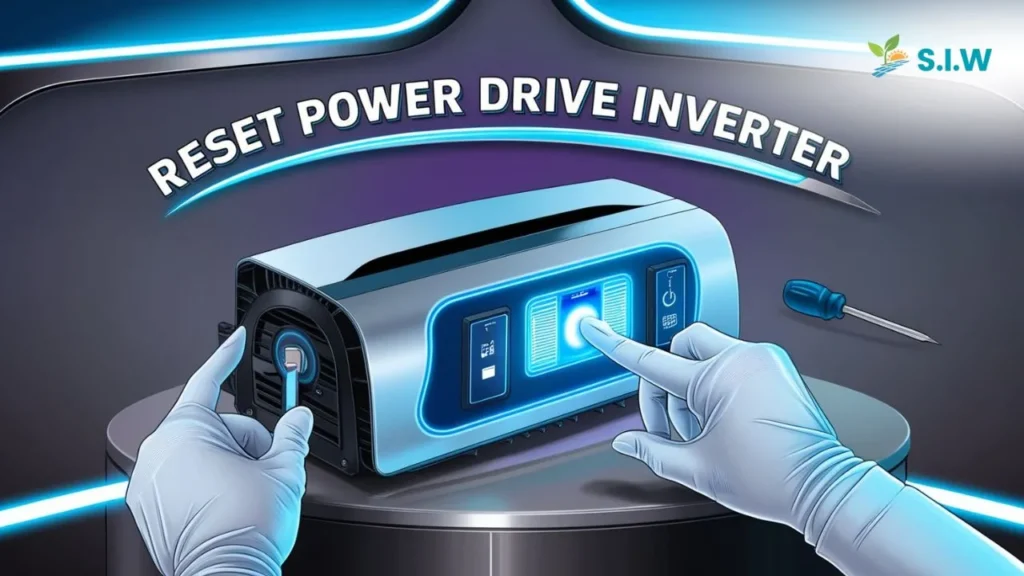Resetting your Power Drive inverter is an essential step when troubleshooting power or connectivity issues. It can help restore the device to optimal working conditions, allowing you to avoid unnecessary repairs or replacements. Follow these comprehensive steps to successfully reset your inverter and ensure it functions properly once more.
Why Would You Need to Reset a Power Drive Inverter?
Power Drive inverters are designed to convert DC (direct current) from sources like batteries into AC (alternating current), powering household devices. Over time, issues such as overloads, voltage fluctuations, or improper usage can cause your inverter to malfunction. Resetting it can resolve issues like:
- Overloading: Exceeding the inverter’s power capacity can trip its safety settings.
- Faulty wiring: Improper connections or loose wires may trigger faults.
- System errors: Software bugs or electrical interference could lead to temporary malfunctions.
Performing a reset can save you time and money, especially when the inverter fails to operate efficiently.
Steps to Reset Your Power Drive Inverter
1. Turn Off the Inverter
Before starting the reset process, turn off the Power Drive inverter by flipping the power switch to the “off” position. This cuts the electrical supply and prevents any accidental short circuits.
- Pro Tip: Allow the inverter to cool for a few minutes to avoid overheating issues.
2. Disconnect the Inverter from All Power Sources
Ensure the inverter is disconnected from all power inputs, including battery connections, solar panels, or other DC sources. This step isolates the inverter from external power and prepares it for a complete reset.
- Important: If you’re dealing with a solar inverter, ensure the photovoltaic (PV) panel is also disconnected.
3. Check the Inverter’s Fuse and Wiring
Inspect the inverter’s fuse for any signs of damage or wear. A blown fuse may indicate that the reset won’t resolve deeper issues, and it might need replacement. Additionally, check all wiring connections to ensure there are no loose or faulty cables.
- Warning: Never touch exposed wiring while the inverter is still connected to any power source.
4. Press the Reset Button (If Applicable)
Many Power Drive inverters come with a dedicated reset button. This button allows you to restore the inverter to its factory settings with ease. Locate the reset button—usually found on the inverter’s control panel—and press it for 10-15 seconds.
- Tip: Use a small pointed object, like a paperclip, to press the reset button if it is recessed.
5. Reconnect the Inverter
After successfully resetting the inverter, reconnect all power sources. Ensure the battery connections are secure, and if you’re using solar energy, reconnect the solar panels.
- Caution: Double-check all wiring to prevent short circuits or overloads.
6. Turn the Inverter Back On
Flip the power switch to the “on” position. Wait for the inverter to boot up, and check whether all the indicator lights are functioning correctly. Most inverters have lights that display power status, faults, or other operational details.
- Reminder: If the inverter doesn’t turn on, repeat the steps or consult the manufacturer’s guide.
Troubleshooting After a Reset
Sometimes, resetting the Power Drive inverter might not fully resolve the issue. Below are a few potential troubleshooting steps if the inverter continues to malfunction:
Check for Overload Issues
Overloading the inverter with excessive electrical devices can cause it to trip its safety mechanism. If you frequently encounter this problem, consider reducing the number of devices connected to the inverter or upgrading to a higher-capacity model.
Inspect for Fault Codes
Many advanced inverters display fault codes on their digital screens or through indicator lights. Consult the inverter’s manual to interpret the error code and take appropriate action.
- Tip: Fault codes often indicate specific problems, such as low battery voltage or temperature overload.
Examine Battery Voltage
A low or faulty battery can cause your inverter to malfunction. Ensure the battery voltage is within the manufacturer’s recommended range. A battery tester can help you determine if the power source is functioning correctly.
Check for Proper Grounding
Ensure the inverter is properly grounded, as poor grounding can result in erratic behavior or electrical shocks. Improper grounding is a common issue in mobile or off-grid solar setups.
Update Firmware (If Applicable)
Some inverters feature upgradable firmware that fixes bugs or improves functionality. Visit the manufacturer’s website to see if there’s a firmware update available for your model and follow their instructions on how to install it.
When to Seek Professional Help
If resetting the Power Drive inverter and troubleshooting doesn’t resolve the problem, it may be time to call a professional technician. Inverters are complex devices, and further issues might require in-depth knowledge of electrical systems or specific repair tools.
Common Reasons to Contact a Professional:
- Repeated system errors or fault codes that don’t go away after resetting.
- Visible damage to the inverter’s internal components, such as melted wiring or burnt circuits.
- Persistent battery or grounding issues that lead to inverter failures.
Preventive Measures to Avoid Future Issues
To minimize the need for future resets, consider the following preventive tips:
- Regularly inspect wiring and connections: Loose or worn-out solar panel wiring can cause short circuits, so check your inverter connections frequently.
- Avoid overloading the inverter: Calculate the total wattage of devices connected to the inverter to ensure it’s within the inverter’s capacity.
- Perform routine maintenance: Clean and check the inverter’s cooling fans, dust the exterior, and follow the maintenance guidelines provided by the manufacturer.
- Install surge protectors: These devices protect the inverter from power spikes caused by lightning or electrical faults in your grid system.
Final Thoughts on Resetting Power Drive Inverters
Resetting your Power Drive inverter is a simple yet crucial task when you encounter system malfunctions. By following the steps outlined above, you can restore your inverter to its original functionality, ensuring it continues to convert energy reliably. Always remember to take proper safety precautions, and don’t hesitate to seek professional help if issues persist.








